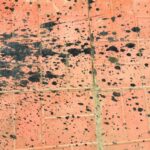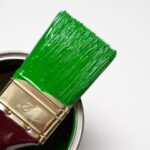Life is messy, and accidents happen! One common mishap is getting paint on your clothes while crafting or during home improvement tasks.
These marks can ruin your garments and seem impossible to remove. But while paint stains can be stubborn, the good news is that you can often remove them successfully with the proper techniques.
This guide walks you through the steps to remove different types of paint stains from your clothes, whether water-based or oil-based paint.
We’ll also share some valuable tips for removing paint and dealing with dried paint stains—the hardest type of paint stain to remove.
How Do You Remove Paint from Clothes?

To successfully remove paint from your clothes, you need to know what type of paint you’re up against.
There are two main types of paints you could be dealing with:
- Water-based paints: Water-based paints, such as acrylics and latex, are made from pigments suspended in water. This means they easily dissolve and can be cleaned with water, making water-based paint stains easier to remove. These paints are most commonly used for painting walls and ceilings or art and craft projects.
- Oil-based paints: Oil-based paints are made from pigments suspended in a solvent, such as mineral spirits or turpentine. This means they’re hydrophobic and cannot be cleaned with water. Instead, they must be washed away with a solvent. These paints are most commonly used for wood and metal painting but can also be used for walls and ceilings.
If you’re unsure what paint you’re dealing with, check the can of paint. Using the proper cleaning method for the type of paint you’ve spilt is crucial for effective results.
Then, check our step-by-step instructions on how to get paint out of clothes below.
How to get water-based paint out of clothes
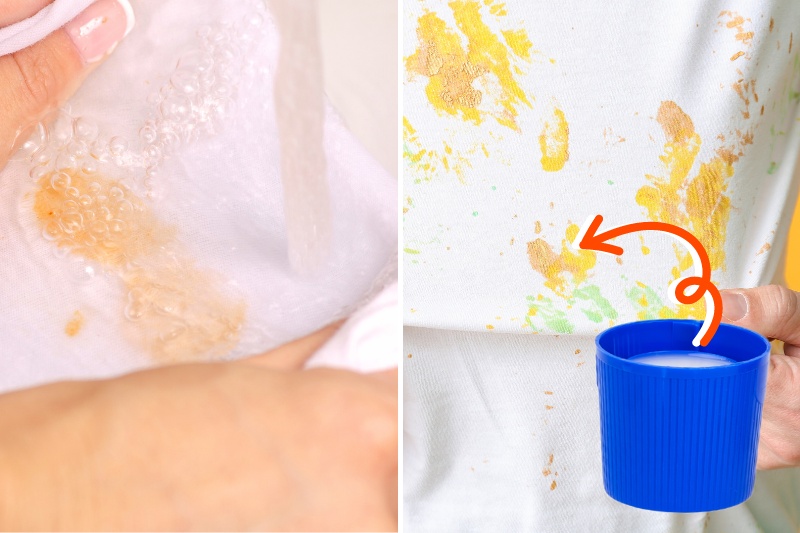
Water-based paints are easier to clean from clothes than oil-based paints. Follow these steps to tackle water-based paint stains:
- Act quickly: The faster you attend to the stain, the better your chances of removing it. As soon as you notice the paint stain, try to remove any excess paint by gently blotting it with a clean cloth or paper towel.
- Flush with water: Turn your garment inside out and rinse the stained area under cold running water from the backside of the fabric. This will help push the paint out of the fibres rather than deeper into the material.
- Pre-treat with detergent: Apply a small amount of washing-up liquid or liquid laundry detergent directly to the paint stain. Gently rub the fabric together to work the soap into the fibres so that it can reach the centre of the stain.
- Soak and rinse: Soak the garment in a 1:1 mixture of cold water and detergent and use a cloth to blot at the stain more. Rinse and repeat the process as needed until the paint is completely lifted from the fabric.
- Apply stain remover: If the paint is still visible, blot the material with non-acetone nail polish remover, hairspray, or rubbing alcohol. The alcohol in these products helps to liquidy hardened paint stains so that they can be lifted from your garments.
- Check for residue: If the stain still persists, repeat the process or try using a paint stain remover product specifically designed for water-based paints. Always test such products on an inconspicuous area first to avoid any damage to the fabric.
- Wash & dry: Once you’re happy the paint has been lifted from the fabric, put your garment in the washing machine on your usual cycle. Afterwards, dry your clothing in the tumble dryer or hang out to air dry.
How to get oil-based paint out of clothes
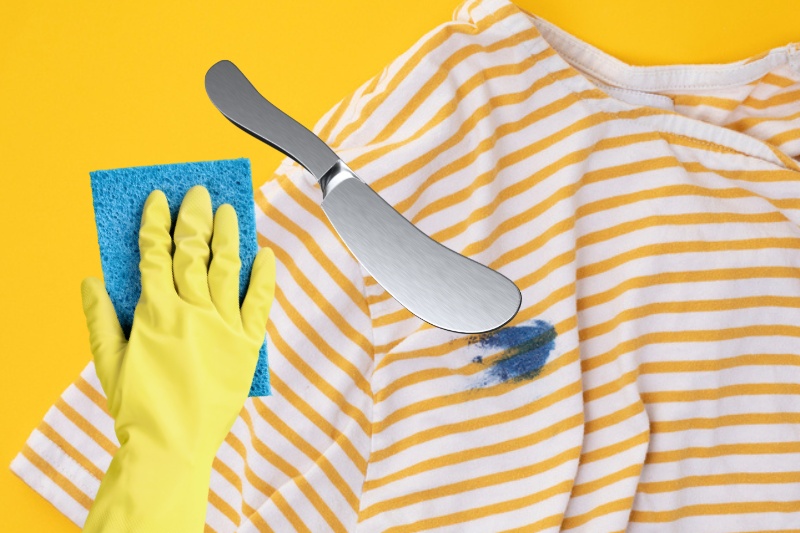
Oil-based paints, including enamel and artist oils, can be more challenging to remove from clothing.
But with a bit of patience and the right approach, it’s still possible to get rid of those stubborn stains.
Here’s the process you should follow:
- Scrape off excess paint: Use a dull knife or spoon to carefully remove any excess paint without spreading it further. It is best to do this as soon as possible, as dried paint stains are much harder to lift from fabrics.
- Spot-test solvent: Dampen a clean cloth with paint thinner, turpentine, or mineral spirits and gently dab an inconspicuous area of the fabric, such as inside the cuff or collar. This is to check that the solvent won’t cause discolouration or damage to your clothing.
- Use a sponge or brush: If no damage occurs, moisten a sponge or soft-bristled brush with the paint thinner and gently work on the stain from the back. Always start from the outer edges and move inward to prevent the paint from spreading outward to other areas.
- Rinse and pre-treat: Rinse the fabric thoroughly with cold water to remove any remaining solvent, then pre-treat the paint stain with a laundry detergent or stain remover containing enzymes. Soak the garment in hot, soapy water overnight.
- Machine wash: The following day, wash the garment in your washing machine on the hottest cycle recommended for the fabric (check the care label). Check the clothing before putting it in the dryer, and repeat the process if the stain is still visible.
Top Tips for Paint Removal from Clothes
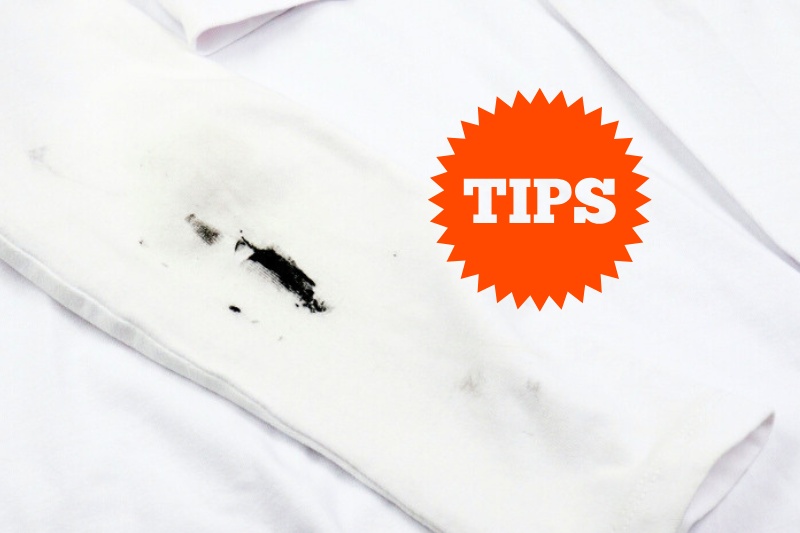
Using the above methods, you should be able to remove all types of paint stains from a huge range of materials.
If you’re struggling, here are some additional tips to improve your chances of successfully getting paint stains out of your clothes:
- Before attempting any stain removal process, read the fabric care label on the garment. Follow the manufacturer’s instructions to avoid damaging the material.
- Always test stain removers or solvents on an inconspicuous area of the fabric to ensure they won’t cause colour fading or damage to the material.
- When removing stains, always turn the garment inside out and work on the stain from the back to help push the pigment out.
- Blot at the stain using gentle motions instead of rubbing vigorously. Rubbing can cause the paint to spread and cause damage to the material.
- Always treat the stain as soon as possible after the paint spill. The quicker you start treating the stain, the more effective your efforts will be.
- Avoid using hot water or heat on the stain until you’re sure it’s entirely removed. Heat can set the paint, making it more challenging to remove.
- Be prepared to repeat the cleaning process several times and try various stain removers. Paint can be a stubborn stain, and you need to be persistent.
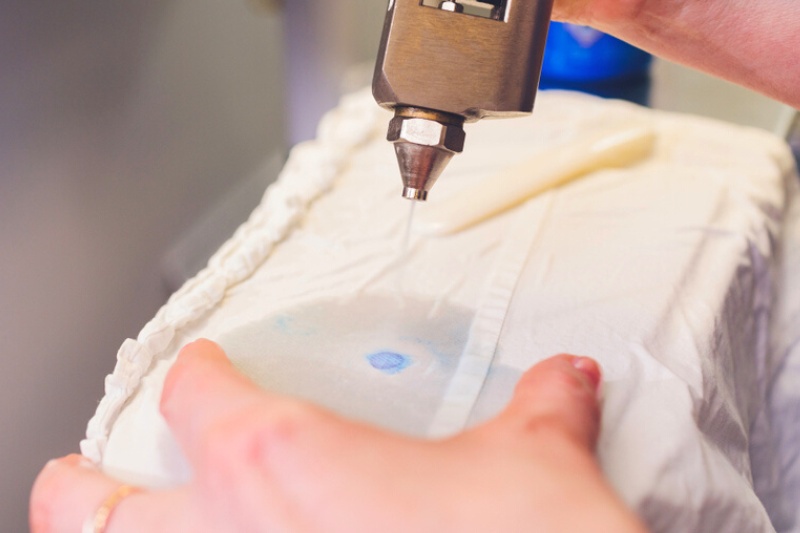
If you cannot remove the paint stain using these tips and processes, consider taking it to a professional dry cleaners.
You could alternatively keep the stained items to wear for other craft or home DIY projects, or consider tie-dying the fabric to create unique wardrobe pieces.

Hannah has a passion for cleaning. She worked her way around Australia by cleaning hostels in exchange for free accommodation and used her cleaning skills to bag a job as a chalet host for a luxury ski company in France.

